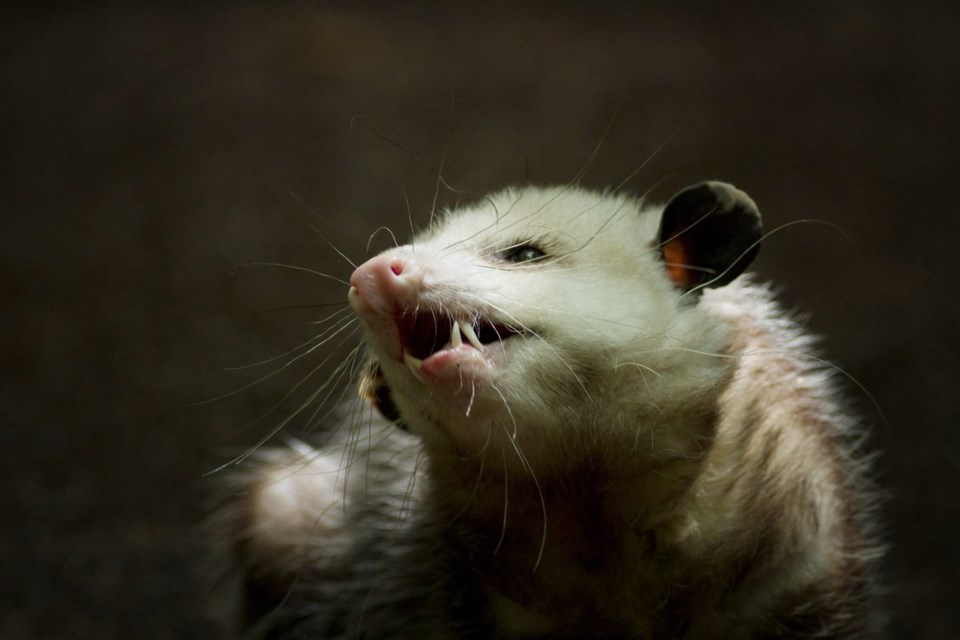MONTREAL — One evening last fall, Robert Carrière was putting away some gardening tools when he saw something scurry out from under the shed.
At first, he thought it was a big rat. Then he thought maybe a muskrat.
What it was, it turned out, was an opossum. It was hanging out near a collective garden at a college in northeastern Montreal, and Carrière, a volunteer at the garden, wasn’t the only person to see one that fall. A campus security guard managed to snap a photo in late October of what is unmistakably an opossum: white face, brown fur and long, naked tail.
“I thought to myself, ‘Wow,’” Carrière said. “‘It’s come from far away.’”
The episode is one of a small but growing number of opossum sightings on the Island of Montreal, which until recently was too cold to play host to North America’s only marsupial. Many Montrealers, and even some biologists, are unaware that opossums are already living among them. But scientists believe the animals will eventually become a fairly commonplace backyard critter on the island — if not as abundant as squirrels or raccoons.
Stéphane Lamoureux, a biologist with the Quebec Environment Department, said he’s been getting sporadic reports of opossums in Montreal for the last decade and that the number of calls is on the rise. He’s had about a dozen so far this year, he said.
“It’s certainly a new species, and people aren’t used to seeing them,” he said. “So people often have a lot of questions about it.”
Like kangaroos and koalas, opossums are marsupials that raise their young in pouches. They can have more than 20 babies at a time, though many of them won't survive. Those that do can be seen clinging to their mother's back as she searches for food. They’re mostly nocturnal and are adept scavengers in urban environments, often hiding under sheds or using old groundhog burrows for shelter.
They are not, perhaps, the most photogenic mammals, but scientists say people have little to fear from opossums. They will bare their teeth and hiss if confronted, but if one feels really threatened, it'll often collapse onto its side, unconscious, and feign death — in other words, play possum.
"I would not consider them an aggressive species unless you're trying to pick one up," said Sheldon Owen, a wildlife specialist at West Virginia University. He said that in his region people are used to seeing opossums in backyards and on roadsides, and mostly they're seen in a positive light. They'll eat tomatoes and sometimes get into garbage or chicken coops, Owen said, but they also clean up roadkill.
"They're actually a benefit across the landscape here in West Virginia," he said.
In recent years, there have been scattered opossum sightings across the island. Montreal resident Karine Huard saw a family of three or four last year in the LaSalle borough, in the southwest part of the city. Earlier this month, Jean-Sébastien Côté saw one outside someone's front door in nearby Côte-St-Paul.
Back in 2021, a longtime employee of the Montreal SPCA got his first call in 42 years of service to rescue an opossum trapped on a busy street near the centre of the city. The group named the animal Blaise and dropped him off at a wildlife refuge.
Still, many people have no inkling that opossums are in the city. Renée Lemieux, an environmental adviser at Marie-Victorin junior college who eventually identified the animal Carrière thought was a giant rat, said everyone was “amazed” when they found out what it really was.
“I thought it was absolutely brilliant,” she said. “Before looking into it, I had no idea you could see them on the Island of Montreal.”
Opossums are found across the eastern United States and Central America. But historically, the northern edge of their range barely crossed the border into southern Quebec, said David Rodrigue, executive director of the Ecomuseum Zoo in Montreal’s West Island.
With their hairless ears and tails, opossums are especially prone to frostbite. They don’t hibernate, so a cold winter can wipe out any animals that venture too far north.
But climate change is expanding their territory. Opossums have been seen in Toronto for at least the last few decades. The late Rob Ford, after his stint as Toronto mayor, once memorably told city council to watch out for the “vicious animals.”
Milder weather has also brought the critters deeper into Quebec, Rodrigue said, and they‚Äôre now often seen on the –°¿∂ ”∆µ Shore, just across the St. Lawrence River from Montreal. ‚ÄúIf it keeps warming up or staying warmer, chances are they‚Äôll establish themselves much more,‚Äù he said.
Rodrigue had not heard of opossums –°¿∂ ”∆µ seen on the island, and immediately wondered how they had crossed the river ‚Äî whether on the ice before the spring melt, or over one of the bridges to Montreal.
“It’s just really interesting that they would have made it onto the island without having been brought,” he said.
Lamoureux said he doesn’t think the city’s opossums will ever rival its population of raccoons, another adaptable scavenger well-known to all Montrealers. But he does think they’re here to stay. “I think it’s going to become a species that we have the opportunity to see in urban environments,” he said, comparing opossums to groundhogs or skunks. “They coexist well with people.”
This report by The Canadian Press was first published June 28, 2024.
Maura Forrest, The Canadian Press



